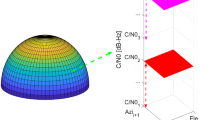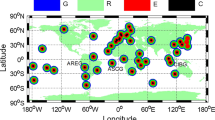Abstract
The multipath effect reduces the accuracy of pseudorange and carrier phase observations and significantly affects the convergence of precise point positioning (PPP) in an urban high-obstruction environment. The multipath hemispherical map (MHM) is based on the spatial repeatability of the multipath and is used to mitigate the multipath effect. This method is widely used because it is suitable for real-time dynamic and static situations with multipath invariance. Although the MHM algorithm is simple and easy to implement, it ignores the spatial distribution of multipath inside the sky grid. It is not suitable for use in high-frequency multipath corrections. By fitting the multipath trend inside the sky grid, the MHM based on a trend-surface analysis (T-MHM) alleviates the high-frequency and low-frequency multipath simultaneously, improving the accuracy of the baseline solution in the differential mode. We mainly demonstrate the application of T-MHM in PPP, analyze the unmodeled errors, evaluate the multipath correction effect of T-MHM, discuss the optimal modeling days, and test its sensitivity in the scale of the sky grid. Compared to MHM, the experimental results show that using T-MHM in multipath correction improves the positioning accuracy in the horizontal and vertical directions by 21.6 and 13.6%, respectively, and shortens the convergence time by 24.2 and 7.2%, respectively. The T-MHM method is not sensitive to the grid scale of the sky, thus resulting in high efficiency.














Similar content being viewed by others
Data Availability
The data used in this manuscript are available from the corresponding author upon request.
References
Atkins C, Ziebart M (2016) Effectiveness of observation-domain sidereal filtering for GPS precise point positioning. GPS Solut 20(1):111–122. https://doi.org/10.1007/s10291-015-0473-1
Banville S, Tang H (2010) Antenna rotation and its effects on kinematic Precise point positioning. In: Proceedings ION GNSS 2010, Institute of Navigation, Portland, OR, September 21–24, pp 2545–2552
Bock Y, Nikolaidis RM, Jonge PJ, Bevis M (2000) Instantaneous geodetic positioning at medium distances with the Global Positioning System. J Geophys Res Solid Earth 105(B12):28223–28253
Choi K, Bilich A, Larson KM, Axelrad P (2004) Modified sidereal filtering: implications for high-rate GPS positioning. Geophys Res Lett. https://doi.org/10.1029/2004gl021621
Cohen CE, Parkinson BW (1991) Mitigating multipath error in GPS based attitude determination. Adv Astronaut Sci 74:53–68
Collins P (2008) Isolating and estimating Undifferenced GPS integer ambiguities. In: Proceedings ION NTM 2008, Institute of Navigation, San Diego, CA, January 28–30, pp 720–732
Dai W, Ding X, Zhu JJ, Chen YQ, Li ZW (2006) EMD Filter Method and Its Application in GPS Multipath. Acta Geodaetica Et Cartographica Sinica 35(4):321–327
Dierendonck AJV, Fenton P, Ford T (1992) Theory and performance of narrow correlator spacing in a GPS receiver. J Inst Navig 39(3):265–283. https://doi.org/10.1002/j.2161-4296.1992.tb02276.x
Dinius AM (1995) GPS antenna multipath rejection performance. Nasa Sti/Recon Tech Rep N 96(58):16–21. https://doi.org/10.1002/wilm.10088
Dong D, Wang M, Chen W, Zeng Z, Song L, Zhang Q, Cai M, Cheng Y, Lv J (2016a) Mitigation of multipath effect in GNSS short baseline positioning by the multipath hemispherical map. J Geod 90(3):255–262. https://doi.org/10.1007/s00190-015-0870-9
Dong D, Chen W, Cai M, Zhou F, Wang M, Yu C, Zheng Z, Wang Y (2016b) Multi-antenna synchronized global navigation satellite system receiver and its advantages in high precision positioning applications. Front Earth Sci 10(4):772–783
Fuhrmann T, Luo X, Knöpfer A, Mayer M (2015) Generating statistically robust multipath stacking maps using congruent cells. GPS Solut 19(1):83–92. https://doi.org/10.1007/s10291-014-0367-7
Ge L, Rizos C, Han S, Sc B, Sc M (2000) Multipath mitigation of continuous GPS measurements using an adaptive filter. GPS Solut 4(2):19–30. https://doi.org/10.1007/PL00012838
Geng J, Bock Y (2016) GLONASS fractional-cycle bias estimation across inhomogeneous receivers for PPP ambiguity resolution. J Geod 90(4):379–396. https://doi.org/10.1007/s00190-015-0879-0
Genrich JF, Bock Y (1992) Rapid resolution of crustal motion at short ranges with the Global Positioning System. J Geophys Res Solid Earth 97(B3):3261–3269
Gill M, Bisnath S, Aggrey J, Seepersad G (2017) Precise point positioning (PPP) using low-cost and ultra-low-cost GNSS teceivers. In: Proceedings ION GNSS 2017, Institute of Navigation, Portland, Oregon, September 25–29, pp 226–236
Groves PD, Jiang Z (2013) Height aiding, C/N0 weighting and consistency checking for GNSS NLOS and multipath mitigation in urban areas. J Navig 66:653–669. https://doi.org/10.1017/S0373463313000350
Groves PD, Jiang Z Skelton B, Cross PA (2010) Novel multipath mitigation methods using a dual-polarization antenna. In: Proceedings ION GNSS 2010, Institute of Navigation, Portland, Oregon, September 2010 21–24, pp 140–151
Hung HK, Rau RJ (2013) Surface waves of the 2011 Tohoku earthquake: observations of Taiwan’s dense high-rate GPS network. J Geophys Res Solid Earth 118:332–345. https://doi.org/10.1029/2012JB009689
IEEE (2008a) Standard specification format guide and test procedure for linear single-axis, non-gyroscopic accelerometers. IEEE Std 1293–1988:166–182
IEEE (2008b) Standard specification format guide and test procedure for single-axis interferometric fiber optic gyros. IEEE Std 952–1997(R2008):61–73
Kouba J (2015) A guide to using international GNSS service (IGS) products. https://kb.igs.org/hc/en-us/articles/201271873-A-Guide-to-Using-the-IGS-Products. Accessed 15 Sept 2019
Li P, Zhang X (2014) Integrating GPS and GLONASS to accelerate convergence and initialization times of precise point positioning. GPS Solut 18(3):461–471. https://doi.org/10.1007/s10291-013-0345-5
Li B, Zhang Z, Shen Y, Yang L (2018) A procedure for the significance testing of unmodeled errors in GNSS observations. J Geod 92:1171–1186
Liu T, Yuan Y, Zhang B, Wang N, Chen Y (2017) Multi-GNSS precise point positioning (MGPPP) using raw observations. J Geod 91(3):253–268. https://doi.org/10.1007/s00190-016-0960-3
Malys S, Jensen PA (1990) Geodetic point positioning with GPS carrier beat phase data from the CASA UNO experiment. Geophys Res Lett 17(5):651–654
Nee RDJV (1995) Multipath and multi-transmitter interference in spread-spectrum communication and navigation systems. Dissertation, Delft University
Nee RDJV, Siereveld J, Fenton PC, Townsend BR (1994) The multipath estimating delay lock loop: approaching theoretical accuracy limits. In: Proceedings of 1994 IEEE position, location and navigation symposium–PLANS’94, Las Vegas, NV, USA, pp 246–251 https://doi.org/10.1109/PLANS.1994.303320
Niu X, Chen Q, Zhang Q, Niu J, Chen K, Shi C, Liu J (2014) Using Allan variance to analyze the error characteristics of GNSS positioning. GPS Solut 18:231–242. https://doi.org/10.1007/s10291-013-0324-x
Pan L, Zhang X, Liu J (2019) A comparison of three widely used GPS triple-frequency precise point positioning models. GPS Solut. https://doi.org/10.1007/s10291-019-0914-3
Ragheb AE, Clarke PJ, Edwards SJ (2007) GPS sidereal filtering: coordinate- and carrier-phase-level strategies. J Geod 81(5):325–335
Riley WJ (2008) Handbook of frequency stability analysis, US Department of Commerce, National Institute of Standards and Technology
Su M, Zheng J, Yang Y, Wu Q (2018) A new multipath mitigation method based on adaptive thresholding wavelet denoising and double reference shift strategy. GPS Solut 22(2):40. https://doi.org/10.1007/s10291-018-0708-z
Takasu T (2006) High-rate precise point positioning: observation of crustal deformation by using 1-Hz GPS data. In: GPS/GNSS Symposium, Tokyo
Wang Z, Chen W, Dong D, Wang M, Cai M, Yu C, Zheng Z, Liu M (2019) Multipath mitigation based on trend surface analysis applied to dual-antenna receiver with common clock. GPS Solut. https://doi.org/10.1007/s10291-019-0897-0
Wang Z, Chen W, Dong D, Zhang C, Peng Y, Zheng Z (2020) An advanced multipath mitigation method based on trend surface analysis. Remote Sens 12:3601
Wu JT, Wu SC, Hajj G, Bertiger WI, Lichten SM (1993) Effects of antenna orientation on GPS carrier phase. Manuscr Geod 18(2):91–98
Zhang X, Zuo X, Pan L (2013) Mathematic model and performance comparison between lonospherefree combined and uncombined precise point positioning. Geomat Inf Sci Wuhan Univ 38(5):561–565
Zhang X, Zhu F, Xue X, Tang L (2015) Using Allan Variance to Analyze the Zero-differenced Stochastic Model Characteristics of GPS. Acta Geod Cartogr Sinica 44(2):119–127s
Zhao J, Hernández-Pajares M, Li Z, Wang L, Yuan H (2020) High-rate Doppler-aided cycle slip detection and repair method for low-cost single-frequency receivers. GPS Solut. https://doi.org/10.1007/s10291-020-00993-0
Zheng K, Zhang X, Li P, Li X, Ge M (2019) Multipath extraction and mitigation for high-rate multi-GNSS precise point positioning. J Geod 93(10):2037–2051
Zhong P, Ding X, Zheng D, Chen W, Huang D (2008) Adaptive wavelet transform based on cross-validation method and its application to GPS multipath mitigation. GPS Solut 12(2):109–117. https://doi.org/10.1007/s10291-007-0071-y
Zhong P, Ding X, Yuan L, Xu Y, Kwok KCS, Chen Y (2010) Sidereal filtering based on single differences for mitigating GPS multipath effects on short baselines. J Geod 84(2):145–158. https://doi.org/10.1007/s00190-009-0352-z
Zhou F (2020) Theory and methodology of multi-GNSS undifferenced and uncombined precise point positioning. Acta Geod Cartogr Sinica 49(7):938
Zhou F, Dong D, Li W, Jiang X, Wickert J, Schuh H (2018) GAMP: an open source software of multi-GNSS precise point positioning using undifferenced and uncombined observations. GPS Solut. https://doi.org/10.1007/s10291-018-0699-9
Zimmermann F, Eling C, Kuhlmann H (2017) Empirical assessment of obstruction adaptive elevation masks to mitigate site-dependent effects. GPS Solut 21(1):1–12
Zumberge J, Heflin M, Jefferson D, Watkins M, Webb F (1997) Precise point positioning for the efficient and robust analysis of GPS data from large networks. J Geophys Res 102(B3):5005–5017. https://doi.org/10.1029/96JB03860
Acknowledgements
This work was sponsored by the National Natural Science Foundation of China (No. 41771475), Social Development Project of Science and Technology Innovation Action Plan of Shanghai (No. 20dz1207107), the Fund of Director of Key Laboratory of Geographic Information Science (Ministry of Education), East China Normal University (Grant No. KLGIS2020C05), and the Fundamental Research Funds for the Central Universities.
Author information
Authors and Affiliations
Corresponding author
Additional information
Publisher's Note
Springer Nature remains neutral with regard to jurisdictional claims in published maps and institutional affiliations.
Rights and permissions
About this article
Cite this article
Lu, R., Chen, W., Dong, D. et al. Multipath mitigation in GNSS precise point positioning based on trend-surface analysis and multipath hemispherical map. GPS Solut 25, 119 (2021). https://doi.org/10.1007/s10291-021-01156-5
Received:
Accepted:
Published:
DOI: https://doi.org/10.1007/s10291-021-01156-5




